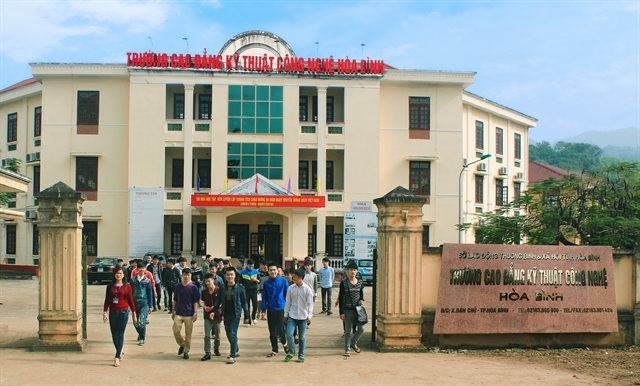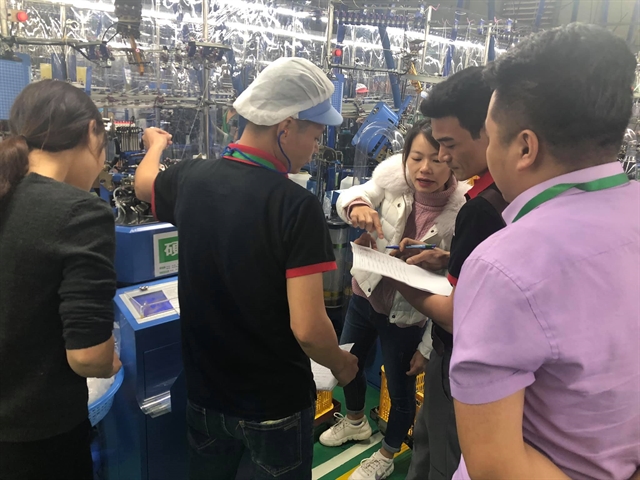 Economy
Economy


|
| Students leaves the Hòa Bình College of Engineering and Technology. Education institutions in the province have designed training programmes suitable to the needs of local enterprises and the socio-economic development requirements of the province— Photo courtesy of the college. |
HÒA BÌNH — The northern province of Hoà Bình has paid great attention to developing high-quality human resources, in the context of globalisation and international economic integration.
In recent years, Hoà Bình has experienced a significant shift in its economic structure with service and tourism becoming key sectors. Currently, the two sectors take the lead in the provincial economic structure while the processing and farming sectors are moving towards high technology production.
Thus, the province has considered increasing labour productivity a decisive factor in sharpening its competitive economic advantage. Human resource training has always been a task of focus for the local authorities.
Accordingly, vocational education institutions in the province have designed training programmes suitable to the needs of local enterprises and the socio-economic development requirements of the province.
Top priorities have been given to developing high-quality human resources served for the province's key economic sectors, encouraging scientists, artisans, technical officers and high-level workers at enterprises to participate in vocational training, linking training with production needs and creating jobs for workers.
Hoà Bình currently has 14 key national-level occupations: automobile technology, construction machine operator, welding, crane operator, hydropower plant operator, animal husbandry and veterinary medicine, garment and fashion technology, computer network administration, tourist guide and electrician. These key occupations have attracted an increasing number of students with annual enrollment exceeding the set targets.
By the end of 2020, there were 39 licensed vocational training institutions eligible to enroll trainees and organise vocational training courses including five colleges, three intermediate schools and 11 vocational training centres. More than 85 per cent of graduated trainees had found jobs and had stable incomes.
Data from Hoà Bình Industrial Zones (IZs) Authority show that businesses in five IZs in the locality has created jobs for more than 19,000 workers as of 2020. Of them, there were 1,064 workers who had university degrees or higher; 1,083 having college degrees; 1,218 gaining intermediate qualifications; more than 2,000 regular vocational training workers; and 11,000 were unskilled workers.
As part of the annual Provincial Competitiveness Index, Hòa Bình Province's labour training index is always higher than the national average. In 2020, Hòa Binh ranked 30th of 63 provinces and cities in this category.

|
| Workers at Hòa Bình Koyuseni Knitting Co. in Hoà Bình Province. Hòa Bình Province's labour training index is always higher than the national average. — Photo courtesy of the company |
Quách Thị Kiều, director of the provincial Department of Labour, Invalids and Social Affairs, said that so far labourers in the province had basically met the needs of businesses. The percentage of trained workers has increased year by year, reaching 56 per cent in 2020 compared to 54 per cent in 2019.
Kiều said her department would continue to promote connections between businesses and vocational training institutions through job fairs and trading platforms.
At the same time, it would also concentrate on improving the quality of human resource training to meet the province's requirements for socio-economic development, she added.
According to experts, in order to better improve the quality of human resources, Hòa Bình Province should have a long-term strategy, paying attention not only to investing in direct human resources but also in developing high-quality human resources.
In term of direct human resources, the province should invest in and socialise vocational training while promoting co-ordination among training institutions and enterprises to bring the capacity of vocational schools and workers into accordance with the needs of enterprises.
In the long term, if the province wants good human resources, they need to do well in career guidance for students. Helping workers access the international labour market should also be included, experts said.
Lưu Tùng Lâm, head of the Enterprise Management Department under the Hoà Bình IZs Authority, suggested that the province pays attention to the socialisation of vocational educational activities to improve the quality of human resources and meet the requirements of economic integration.
"More importantly, it is necessary for the province to guide vocational schools to expand into new occupations and develop new forms of vocational training," Lâm told an online newspaper.
"While many vocational training institutions have not yet to offer high-skilled training, the province should encourage enterprises to set up on-site training centres, which could participate in training students and internships," he said.
Lâm also petitioned the province to organise the labour supply network well, and set up a data system on labour supply and demand. —VNS




